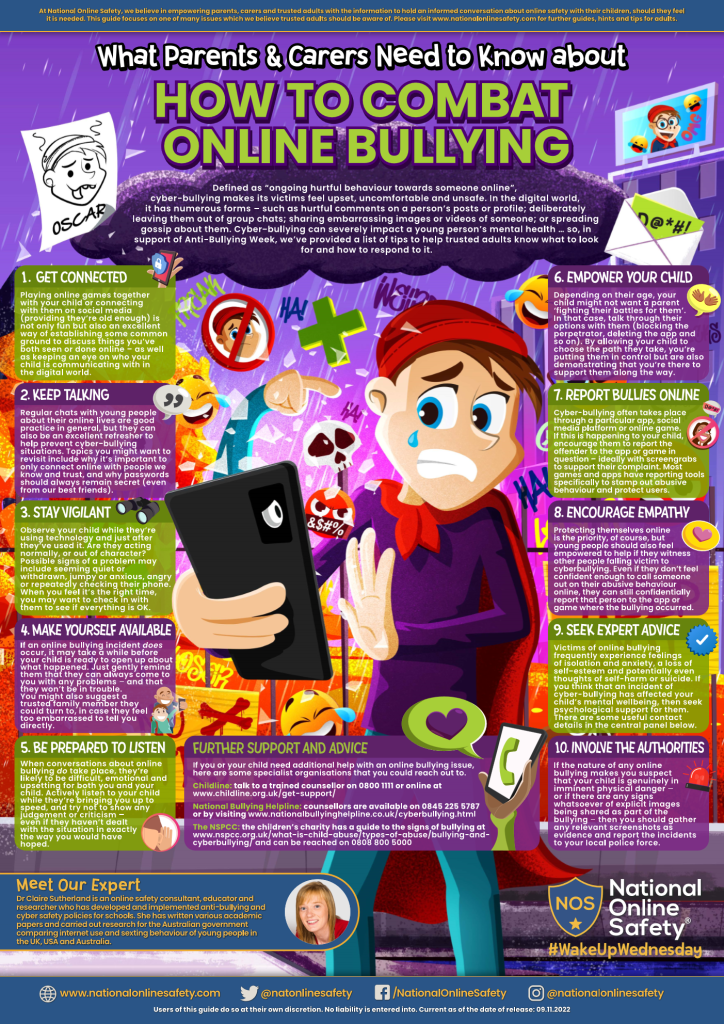For Anti-Bullying Week, we wanted to share some resources about sharing kindness and combatting bullying online. Click on the images for larger .pdf versions.


These guides are from National Online Safety.
For Anti-Bullying Week, we wanted to share some resources about sharing kindness and combatting bullying online. Click on the images for larger .pdf versions.


These guides are from National Online Safety.
It’s just one of several changes that have set the social media giant on what many consider a concerning path in online safety terms. This #WakeUpWednesday guide provides a run-down of the most significant tweaks made to X; their potential safeguarding implications; and how to help ensure young people minimise the risks while they continue to use the service.
Grab the new guide below!National Online Safety
This guide is from National Online Safety.
According to Ofcom, WhatsApp is used by more than half of 3- to 17-year-olds in the UK (including one in three from the 8–11 bracket), despite its 16+ age restriction. If your child hops onto WhatsApp to stay in touch with friends or family, our updated guide to the service contains the key details you’ll need to support them in doing it safely.
Encrypting messages to protect users’ privacy has undeniable merit, but it also poses obvious risks – especially to young people. Updated to reflect the newest version of WhatsApp, this #WakeUpWednesday guide brings trusted adults the latest essential info.
Grab our new guide below!National Online Safety
This guide is from National Online Safety.
Admin Officer
26/11/2023
Grade 4 (£21,475 to £22,288 FTE per annum) reduced pro-rata. Pay award pending.
Term-Time Only contract – 39 weeks plus 9 days in school holidays, plus holiday entitlement. 7.5hrs per day, part-time basis
22.5
Lord Deramore’s Primary School is seeking a friendly, organised and hardworking part-time school office administrator to join our school community. The role will involve running our school office for three days per week (ideally Mondays, Tuesdays and Wednesdays) in a job-share role with the other Admin Officer who currently works Wednesdays, Thursdays and Fridays. Main tasks will include:
Working days would ideally be Mondays, Tuesdays and Wednesdays (subject to negotiation with successful candidate) – 8.30am-4.30pm, with 30 minutes for lunch. School term-time only plus 3 weeks (9 days) to be worked during the school holidays at a mutually-convenient time.
The school is committed to safeguarding and promoting the welfare of children and young people and expects all staff and volunteers to share this commitment. We require the successful applicant to undertake an enhanced Criminal Record check via the Disclosure and Barring Service.
For further details please email: office.ld@york.gov.uk
An application form is available to download here.
Please submit completed forms electronically to office.ld@york.gov.uk by Sunday 26 November at 12 midnight.
Closing date: Sunday 26 November 2023 at 12 midnight
Shortlisted candidates notified by: Thursday 30 November 2023
Interview date: Wednesday 6 December 2023
In reality, the topic has become increasingly complex – with respect for other people’s children who might also be in the photos and our own child’s future feelings among the considerations. This #WakeUpWednesday guide assesses the potential pitfalls of publicly posting our pics.
Grab our new guide below!National Online Safety
This guide is from National Online Safety.
With platforms such as YouTube, Facebook, TikTok and Twitch all offering routes to a vast online audience, young people have enthusiastically taken up the baton – streaming on subjects from gaming to sports to live shopping (yes, really!). Potentially having strangers among one’s viewers, though, is just one of many concerns. Our #WakeUpWednesday guide has the key information.
Read on to access your free guide…National Online Safety
This guide is from National Online Safety.

A few weeks ago, a Y3 hedgehog hero found this hog who was very confused and out and about in the day. After a stay with Fiona at Urchins Hedgehog Care, York, he’s back!
We love happy endings and are grateful to both Rob, of Minster Lions, for transportation and to Fiona for her dedication.
Lord Deramore’s is very proud to be a Hedgehog-friendly school!
As young people’s screen time almost inevitably increases over the holidays, parents like to feel confident that their child will stay safe while they’re exploring the digital world. So we’ve produced a #WakeUpWednesday poster with some simple solutions to help children avoid frequent online pitfalls and enjoy a more positive experience when they go online this summer.
Read on to access your free guide…National Online Safety
This guide is from National Online Safety.
Representative of the School Council met with some of the school’s Governing Body to share with them a presentation and a summary of the School Council’s activities in 2022-2023. They did an excellent job of communicating clearly and confidently with their audience!
Please scroll through the slideshow below, or click here for a .pdf version of the slides
There’s Replika and Kuki, for instance, while Snapchat has recently got in on the act with My AI – and search engines like Bing and Google have developed their own versions. Are these machine intelligences suitable online companions for young people? What are their limitations and weak spots? Our #WakeUpWednesday guide profiles the emergence of AI ‘virtual friends’.
Read on to access your free guide…National Online Safety
This guide is from National Online Safety.